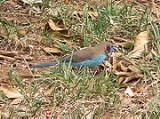
Red-cheeked Cordon-bleu
Encyclopedia
The Red-cheeked Cordon-bleu (Uraeginthus bengalus) is a small passerine
bird
. This estrildid finch
is a resident breeding bird in drier regions of tropical sub-Sahara
n Africa
. Red-cheeked Cordon-bleu has an estimated global extent of occurrence of 7,700,000 km².
and other seed
s. It is frequently seen at open dry grassland
and savanna
habitats as well as around human habitation. The nest
is a large domed grass
structure with a side entrance in a tree, bush or thatch into which 4-5 white eggs
are laid.
Passerine
A passerine is a bird of the order Passeriformes, which includes more than half of all bird species. Sometimes known as perching birds or, less accurately, as songbirds, the passerines form one of the most diverse terrestrial vertebrate orders: with over 5,000 identified species, it has roughly...
bird
Bird
Birds are feathered, winged, bipedal, endothermic , egg-laying, vertebrate animals. Around 10,000 living species and 188 families makes them the most speciose class of tetrapod vertebrates. They inhabit ecosystems across the globe, from the Arctic to the Antarctic. Extant birds range in size from...
. This estrildid finch
Estrildid finch
The estrildid finches are small passerine birds of the Old World tropics and Australasia. They can be classified as the family Estrildidae , or as a sub-group within the family Passeridae, which also includes the true sparrows....
is a resident breeding bird in drier regions of tropical sub-Sahara
Sahara
The Sahara is the world's second largest desert, after Antarctica. At over , it covers most of Northern Africa, making it almost as large as Europe or the United States. The Sahara stretches from the Red Sea, including parts of the Mediterranean coasts, to the outskirts of the Atlantic Ocean...
n Africa
Africa
Africa is the world's second largest and second most populous continent, after Asia. At about 30.2 million km² including adjacent islands, it covers 6% of the Earth's total surface area and 20.4% of the total land area...
. Red-cheeked Cordon-bleu has an estimated global extent of occurrence of 7,700,000 km².
Description
The Red-cheeked Cordon-bleu is 12 centimetres (4.7 in) in length. The adult male has uniformly brown upperparts, pale blue breast, flanks and tail and a yellow belly. There is a red patch on each cheek. Females are similar but duller, and lack the cheek spot. Immature birds are like the female, but with blue restricted to the face and throat.Voice
It has a piping tsee-tsee call which is a familiar African sound. The song is a wit-sit-diddley-diddley-ee-ee.Behaviour
The Red-cheeked Cordon-bleu is a small gregarious bird which feeds mainly on grainGRAIN
GRAIN is a small international non-profit organisation that works to support small farmers and social movements in their struggles for community-controlled and biodiversity-based food systems. Our support takes the form of independent research and analysis, networking at local, regional and...
and other seed
Seed
A seed is a small embryonic plant enclosed in a covering called the seed coat, usually with some stored food. It is the product of the ripened ovule of gymnosperm and angiosperm plants which occurs after fertilization and some growth within the mother plant...
s. It is frequently seen at open dry grassland
Grassland
Grasslands are areas where the vegetation is dominated by grasses and other herbaceous plants . However, sedge and rush families can also be found. Grasslands occur naturally on all continents except Antarctica...
and savanna
Savanna
A savanna, or savannah, is a grassland ecosystem characterized by the trees being sufficiently small or widely spaced so that the canopy does not close. The open canopy allows sufficient light to reach the ground to support an unbroken herbaceous layer consisting primarily of C4 grasses.Some...
habitats as well as around human habitation. The nest
Bird nest
A bird nest is the spot in which a bird lays and incubates its eggs and raises its young. Although the term popularly refers to a specific structure made by the bird itself—such as the grassy cup nest of the American Robin or Eurasian Blackbird, or the elaborately woven hanging nest of the...
is a large domed grass
Grass
Grasses, or more technically graminoids, are monocotyledonous, usually herbaceous plants with narrow leaves growing from the base. They include the "true grasses", of the Poaceae family, as well as the sedges and the rushes . The true grasses include cereals, bamboo and the grasses of lawns ...
structure with a side entrance in a tree, bush or thatch into which 4-5 white eggs
Egg (biology)
An egg is an organic vessel in which an embryo first begins to develop. In most birds, reptiles, insects, molluscs, fish, and monotremes, an egg is the zygote, resulting from fertilization of the ovum, which is expelled from the body and permitted to develop outside the body until the developing...
are laid.
Origin
Origin and phylogeny has been obtained by Antonio Arnaiz-Villena et al. Estrildinae may have originated in India and dispersed thereafter (towards Africa and Pacific Ocean habitats).External links
- BirdLife Species Factsheet
- Red-cheeked Cordon-bleu videos, photos & sounds on the Internet Bird Collection

